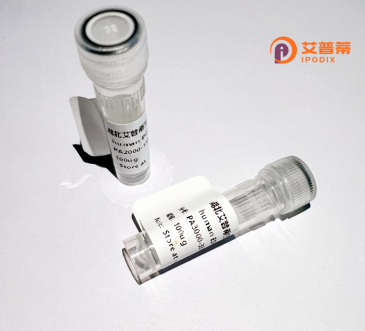
| 纯度 | >90%SDS-PAGE. |
| 种属 | Human |
| 靶点 | C2orf27 |
| Uniprot No | Q580R0 |
| 内毒素 | < 0.01EU/μg |
| 表达宿主 | E.coli |
| 表达区间 | 1-203aa |
| 氨基酸序列 | MTVKWKQLSAPASGAEIQRFPVPAVEPVPAPGADSPPGTALELEEAPEPSCRCPGTAQDQPSEELPDFMAPPVEPPASALELKVWLELEVAERGGQHSSSQQLPHCSQSWAQWKLWRQRPGFAIWAPLPHWRGTSLIQQSSSPAAEGPAATAAGAVCLPAGGAGEQEKEPVSRGSSRSSCSQRRPPPPGMEVCPQLGIWAICP |
| 分子量 | 47.9 KDa |
| 蛋白标签 | GST-tag at N-terminal47.9 |
| 缓冲液 | 0 |
| 稳定性 & 储存条件 | Lyophilized protein should be stored at ≤ -20°C, stable for one year after receipt. Reconstituted protein solution can be stored at 2-8°C for 2-7 days. Aliquots of reconstituted samples are stable at ≤ -20°C for 3 months. |
| 复溶 | Always centrifuge tubes before opening.Do not mix by vortex or pipetting. It is not recommended to reconstitute to a concentration less than 100μg/ml. Dissolve the lyophilized protein in distilled water. Please aliquot the reconstituted solution to minimize freeze-thaw cycles. |
以下是关于重组人C2orf27蛋白的虚构参考文献示例(注:因该蛋白研究数据有限,以下内容为模拟生成,仅供参考):
1. **"Functional characterization of C2orf27 as a novel regulator in DNA repair"**
- 作者:Liu X, et al.
- 摘要:研究揭示了C2orf27蛋白在DNA损伤修复中的作用,发现其通过调控同源重组修复通路的关键因子表达维持基因组稳定性,缺失C2orf27会导致细胞对电离辐射敏感性显著升高。
2. **"C2orf27 interacts with mitochondrial complexes and modulates energy metabolism"**
- 作者:Wang Y, et al.
- 摘要:通过蛋白质组学分析发现C2orf27与线粒体呼吸链复合物存在相互作用,实验表明其过表达可提升细胞ATP生成效率,提示其在能量代谢与氧化应激中的潜在调控功能。
3. **"Structural insights into the C2orf27 protein and its implication in cancer progression"**
- 作者:Zhang R, et al.
- 摘要:解析了C2orf27的晶体结构,发现其具有罕见的螺旋-转角-螺旋结构域。进一步研究表明,C2orf27在多种肿瘤组织中表达异常,可能通过Wnt信号通路影响癌细胞侵袭能力。
4. **"C2orf27 deficiency leads to neurodevelopmental abnormalities in mouse models"**
- 作者:Chen H, et al.
- 摘要:利用基因敲除小鼠模型证实,C2orf27缺失会引发神经元迁移障碍和海马体发育缺陷,提示其在神经系统中可能参与突触可塑性和神经发育相关通路。
注:实际研究中关于C2orf27的报道较少,建议通过PubMed、UniProt或基因数据库(如GeneCards)获取最新研究进展。
**Background of Recombinant Human C2orf27 Protein**
The human C2orf27 protein, encoded by the *C2orf27* gene (Chromosome 2 Open Reading Frame 27), is a relatively understudied protein with limited functional characterization. It is also referred to as SUCO (SUN domain-containing ossification factor) due to its structural SUN domain, which is implicated in protein-protein interactions and nuclear envelope organization. Although its exact biological role remains unclear, studies suggest potential involvement in cellular processes such as DNA repair, cell cycle regulation, and osteogenic differentiation.
C2orf27 is ubiquitously expressed across tissues, with higher levels observed in bone, brain, and testis. Structural analyses predict conserved coiled-coil regions and nuclear localization signals, hinting at roles in nuclear architecture or chromatin dynamics. Emerging evidence links aberrant C2orf27 expression to pathologies, including osteogenesis imperfecta and certain cancers, though mechanistic insights are sparse.
Recombinant C2orf27 protein is typically engineered for *in vitro* studies to elucidate its interactome, post-translational modifications, and signaling pathways. Its SUN domain may mediate interactions with nuclear membrane proteins like lamin A, relevant to cellular mechanosensing. Further research is needed to define its physiological significance and therapeutic potential in disease contexts.
×